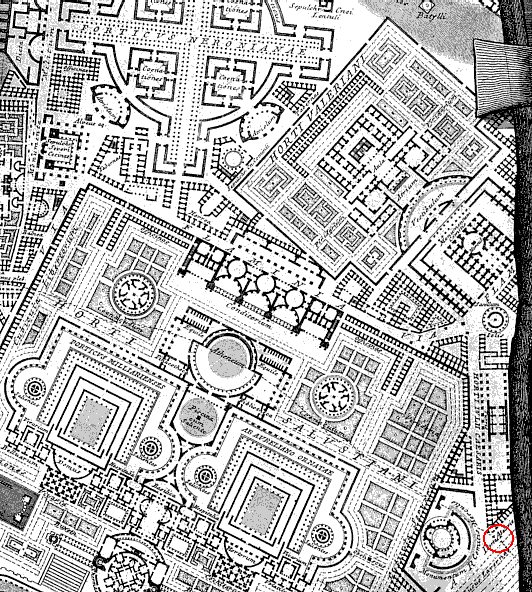Vincenzo Fasolo, "The Campo Marzio of G. B. Piranesi".
2691a
2691e
1956
Porticus Neronianae and the circle/square juncture
1998.08.18
...the cruciform Porticus Neronianae is not only somewhat similar to the Villa Rotonda, but also seems to be generated by the circle/square juncture diagram.
Porticus
1998.12.01
The porticus is the most prevalent building typology within the Ichnographia Campus Martius. At least one porticus is found within every quadrant of the large plan, and cumulatively they add up as the most numerous building type within the Campus Martius, a portrayal which is both historically and archeologically sound. That is not to say, however, that each porticus Piranesi delineates has a historical basis. For example, the two Porticus Hadriani, the Porticus Horti Domitiae, at least one of the Porticus Neronianae, the Porticus praebentes umbraculum diei ab aesti, the Porticus Quirini, and the Porticus Trajani have no relationship with historical fact. Furthermore, many of those porticus that hold factual veracity, Piranesi dislocates within the large plan, and, overall, none of the porticus within the Ichnographia, with the exception of the Porticus Septorum Juliorum, express historically correct designs.
Even though Piranesi employs a different imaginative arrangement for each porticus delineated within the Ichnographia, he nonetheless exhibits an overall consistency within a discernible set of design patterns. Each porticus contains a profusion of colonnades. The oldest porticus are simply linear in plan, and those along major axes such as the Via Lati and the Equiria are linear in the extreme. The Porticus Horti Domitiae and the Porticus Europae incorporate circular motifs, and the two Porticus Neronianae are cruciform in plan. Finally, the porticus of Hadrian and the later emperors are very hybrid in that they incorporate any number of colonnade plan motifs, as well as contain an array of enclosed spaces.
Campo Marzio discoveries
2004.03.18
2. the circle/square Porticus Neronianae marks the spot of Alaric's Visigoth camp prior to the (primal) break-in at the Porta Saleria. The 45 degree marks of the Porticus Neronianae marks the four cardinal points. Since the compass of the Ichnographia matches the center of the Porticus Neronianae in size, perhaps Piranesi is here indicating the spot where the "winds" shifted--the historical winds. I now know how the Nolli map corresponds with the Campo Marzio area of the Celian Hill/Horti Salustiani. Platner provides an interesting history of the "Domus Valerianus"--nobody bought it in 404 AD; it sold for almost nothing after Alaric 410 AD; it appears to have become a hospital (which makes sense with regard to Melania's mission.
| |
Re: crossology
2004.04.01 12:47
Not too long ago, countable days actually, I first learned of Melania the Younger, and how her husband's (enormously expensive) family estate [Horti Valeriani] just outside the walls of Rome at the Salarian Gate, was one of the great properties (along with the Gardens of Sallust) that were plundered when Alaric and his Visigoths broke into (at the Salarian Gate) and sacked Rome for the first time. The Visigoths initially camped for many months outside the walls of Rome (near the Salarian Gate) thereby starving the city by disrupting all deliveries of grain from Africa to the city. The Salarian Gate, the Gardens of Sallust, and the Gardens Valeriani are all delineated within Piranesi's Ichnographia Campus Martius right where they are supposed to be. Interesting, right next to this complex of buildings/structures, Piranesi also delineates a Porticus Neronianae, a completely fictitious building in the shape of a large cross within a circle (a composition, coincidentally, that follows the circle/square juncture pattern similar to the Timepiece gauge of the theory of chronosomatics). Within a day of assimilating all this new data, I came to see how the inner circle of the Porticus Neronianiae matches the circle of the compass/north arrow that Piranesi also delineated within the Ichnographia, and I came to see how if you rotate the cross of the Porticus Neronianae 45 degrees, its four points then correspond exactly to the four cardinal points of global direction. The Porticus Neronianae of Piranesi's Ichnographia Campus Martius is the X that marks the spot where the first attacking Visigoths camped. [There are even more 'symbols' to interpret here, like 'shifting winds' and Nero as anti-Christ precursor, but more on that latter.]

Giovanni Battista Piranesi, Ichnographia Campus Martius (1762), detail.
The Horti Valeriani is situated in the upper right corner, directly above the Horti Sallustiani, which occupies the entire bottom portion of the plan. Note that the Aurelian Wall is delineated via a bowing dotted line, which is visible directly above the words 'Horti' and 'Sallustiani'. The position of the Salarian Gate is indicated along the dotted line, here circled in red.
|